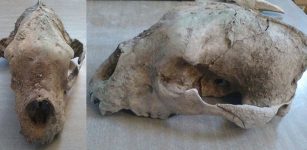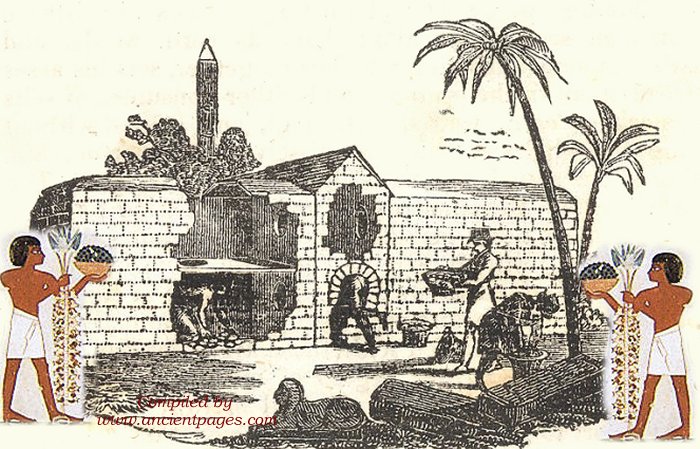Ancient Egyptians Invented World’s Oldest Egg Ovens And They Are Still In Use
Jan Bartek - AncientPages.com - The ancient Egyptian egg ovens are an excellent example demonstrating one should not underestimate how clever our ancestors were.
About 2,000 years ago, Egyptians came up with the incredible idea of producing enormous eggs. They constructed an egg incubator that could produce as many as 4,500 fertilized eggs in just two or three weeks!
The ancient Egyptian mud ovens were designed to replicate the conditions under a broody hen, and the invention worked perfectly. Today, considered the world's oldest man-made incubators, this ancient hatching system was using artificial heat. The largest egg oven had a capacity of 80,000 eggs.
Ancient Egyptians were very secretive with their egg ovens, but the technology was long kept secret. Still, knowledge of this invention spread to neighboring lands. Some curious scholars wanted to see whether the ancient Egyptian egg incubators were as incredible as they were said to be.
Diodorus Siculus ( 90 B.C – 30 B.C), a Greek historian known for his universal history Bibliotheca Historica was so impressed with the Egyptian egg ovens that he described the technology in his compendium Library of History.
"The most astonishing fact is that, because of their unusual application to such matters, the men [in Egypt] who have charge of poultry and geese, in addition to producing them in the natural way known to all mankind, raise them by their own hands, by virtue of a skill peculiar to them, in numbers beyond telling," Diodorus Siculus stated in his ancient work.
Aristotle and Diodorus were equally impressed with the egg incubators and described them as ingenious.
"Traverse section and perspective elevation of an Egyptian Egg-oven." Published in "The Penny Magazine", Volume II, Number 87, August 10, 1833. Credit: Public Domain
The Irish friar Simon Fitzsimons who visited Egypt, said the egg ovens were supernatural.
"Also in Cairo, outside the Gate and almost immediately to the right … there is a long narrow house in which chickens are generated by fire from hen eggs, without cocks and hens, and in such numbers that they cannot be numbered,"
Fitzsimons said, referring to the Egyptian egg incubators.
The fact that ancient Egyptians were unwilling to share their technological secrets made it challenging to create a similar egg incubator, but many tried.
One of the best accurate descriptions of the Egyptian egg ovens comes from the Frenchman René-Antoine Ferchault de Réamur who visited the country in 1750 and described the mega incubators in his book “Art de faire éclorre et d’élever en toute saison des oisseaux” (1751).
Réaumur wrote that the people working in the ovens were almost like a caste and came from the same village and region: Bermé in the Nile Delta. One man was enough to operate a hatchery, which was active for six months in succession, for eight hatching rounds of incubated chicken eggs. The workers from Bermé learned this art handed down from father to son.
It was a heated brick structure, formed by a central corridor with openings, which gave access on both sides to many compartments in two tiers – an average of 5 per side –each of which was laying 4500 eggs on the ground floor. The upper and lower chambers communicated with the corridor through an opening that allowed access to a man.
In the lower chamber were the eggs, arranged on mats or tow, and communicated with the upper chamber through a central opening whose dimensions are such as to allow the heat from above to reach the eggs in the incubation chamber. In the upper room, in a peripheral groove, cow dung or dromedary dung was burnt, dried, mixed with straw, and then compressed. Thus, a smoldering fire was obtained, which was lit twice daily, morning and evening, and mats were applied to half of the vent hole of the upper chamber. As a result, the hot air was forced to pass through the corridor.
Every day the eggs were turned, transferred to any other point warmer or cooler when needed, and partly transferred into the upper chamber when the fire was no longer lit. The man in charge of the incubator was such an expert that he did not need a thermometer – although they were nonexistent. The temperature of the eggs was checked by the egg against the cheek or against an eyelid. Two-thirds of the incubated eggs hatched." 1
Today, there are about 200 such egg ovens used in Egyptian rural areas. Incredibly, the technology invented 2,000 years ago has passed the test of time!
Written by Jan Bartek - AncientPages.com Staff Writer
Updated on December 28, 2022
Copyright © AncientPages.com All rights reserved. This material may not be published, broadcast, rewritten or redistributed in whole or part without the express written permission of AncientPages.com
Expand for references- Elio Corti, Elly Vogelaar – The Oldest Hatcheries Are Still In Use - aviculture-europe.nl
- Wikipedia
More From Ancient Pages
-
 Man-Made Square Burial Cave Dated To Rameses II-Era Accidentally Found In Israel
Archaeology | Sep 19, 2022
Man-Made Square Burial Cave Dated To Rameses II-Era Accidentally Found In Israel
Archaeology | Sep 19, 2022 -
 Mystery Of Nebra Sky Disk: New Analysis Shows Surprising Results
Artifacts | Sep 4, 2020
Mystery Of Nebra Sky Disk: New Analysis Shows Surprising Results
Artifacts | Sep 4, 2020 -
 Pharaoh Merneptah – His Giant Sarcophagus And Unique Victory Stele
Featured Stories | Apr 17, 2018
Pharaoh Merneptah – His Giant Sarcophagus And Unique Victory Stele
Featured Stories | Apr 17, 2018 -
 Ancient Depictions Of Eyes Reveal The Untold Story Of The Human Race – Professor Discovered
Ancient Mysteries | Apr 19, 2019
Ancient Depictions Of Eyes Reveal The Untold Story Of The Human Race – Professor Discovered
Ancient Mysteries | Apr 19, 2019 -
 Did Ancient Seafarers In Southeast Asia Build Sophisticated Boats As Far Back As 40,000 Years Ago?
Archaeology | Feb 24, 2025
Did Ancient Seafarers In Southeast Asia Build Sophisticated Boats As Far Back As 40,000 Years Ago?
Archaeology | Feb 24, 2025 -
 Fossil Bones From The Largest Penguin That Ever Lived Unearthed In New Zealand
Fossils | Feb 10, 2023
Fossil Bones From The Largest Penguin That Ever Lived Unearthed In New Zealand
Fossils | Feb 10, 2023 -
 Strange Ancient And Medieval Encounters With Unusual Beings Reported And Documented
Featured Stories | Jan 15, 2024
Strange Ancient And Medieval Encounters With Unusual Beings Reported And Documented
Featured Stories | Jan 15, 2024 -
 Unusual Viking Secret Hidden Underground In California Reminds Of A Similar Discovery In Colorado
Featured Stories | Sep 12, 2024
Unusual Viking Secret Hidden Underground In California Reminds Of A Similar Discovery In Colorado
Featured Stories | Sep 12, 2024 -
 Catherine Of Alexandria Courageously Confronted 50 Pagan Philosophers And Was Sentenced To Death
Featured Stories | Oct 15, 2018
Catherine Of Alexandria Courageously Confronted 50 Pagan Philosophers And Was Sentenced To Death
Featured Stories | Oct 15, 2018 -
 Christian Church And Large House Unearthed In Ancient Laodicea, A Major Hub Of Christianity
Archaeology | Oct 31, 2020
Christian Church And Large House Unearthed In Ancient Laodicea, A Major Hub Of Christianity
Archaeology | Oct 31, 2020 -
 Why Did Neanderthals Visit A Special Cave In Jersey For Over 100,000 Years?
Archaeology | Dec 13, 2016
Why Did Neanderthals Visit A Special Cave In Jersey For Over 100,000 Years?
Archaeology | Dec 13, 2016 -
 Controversial Tunnel Plan Near Stonehenge Gets U.K. Government Approval – Shocked And Angry Opponents Will Challenge The Decision In High Court
News | Nov 13, 2020
Controversial Tunnel Plan Near Stonehenge Gets U.K. Government Approval – Shocked And Angry Opponents Will Challenge The Decision In High Court
News | Nov 13, 2020 -
 Strange Reports Of A Mysterious Stone-Throwing Phenomenon And Invisible Entity Encountered Worldwide
Featured Stories | Dec 4, 2023
Strange Reports Of A Mysterious Stone-Throwing Phenomenon And Invisible Entity Encountered Worldwide
Featured Stories | Dec 4, 2023 -
 A Scientific Surprise: Bering Land Bridge Formed Late During Last Ice Age
Archaeology | Dec 27, 2022
A Scientific Surprise: Bering Land Bridge Formed Late During Last Ice Age
Archaeology | Dec 27, 2022 -
 Galileo Galilei’ Long-Lost Letter Reveals His Attempt To Fool The Inquisition And Make Science Independent From Religion
Archaeology | Sep 22, 2018
Galileo Galilei’ Long-Lost Letter Reveals His Attempt To Fool The Inquisition And Make Science Independent From Religion
Archaeology | Sep 22, 2018 -
 ‘Collata Quipu’ May Explain Messages Hidden In Mysterious Writing Of Inca
Archaeology | May 10, 2017
‘Collata Quipu’ May Explain Messages Hidden In Mysterious Writing Of Inca
Archaeology | May 10, 2017 -
 Okanagan Indians’ Fascinating Myth Of A Lost Paradise Island Inhabited By White Giants – Are Their Descendants Living in British Columbia?
Featured Stories | Mar 27, 2025
Okanagan Indians’ Fascinating Myth Of A Lost Paradise Island Inhabited By White Giants – Are Their Descendants Living in British Columbia?
Featured Stories | Mar 27, 2025 -
 Ancient DNA From Medieval Germany Reveals The True Story Of Ashkenazi Jews
Archaeology | Nov 28, 2022
Ancient DNA From Medieval Germany Reveals The True Story Of Ashkenazi Jews
Archaeology | Nov 28, 2022 -
 Skull And Jaw Of Giant Bear Of The Late Pleistocene Found In Buenos Aires
Archaeology | Mar 15, 2018
Skull And Jaw Of Giant Bear Of The Late Pleistocene Found In Buenos Aires
Archaeology | Mar 15, 2018 -
 Fate Of The Woman Whose Mysterious Doppelgänger Ruined Her Life
Featured Stories | Mar 6, 2023
Fate Of The Woman Whose Mysterious Doppelgänger Ruined Her Life
Featured Stories | Mar 6, 2023


